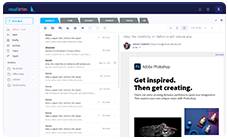Practical Ways To Boost Your Remote Teams Workflow
- 3 years ago
- By srujana

Did you know that remote work accounts for over 15% of opportunities in the United States? It is approximately three times higher compared to 2020. Currently, nearly 16% of the companies in the US are working remotely. And it is estimated that approximately 36.2 Million Americans will work remotely by 2025.
By considering all this data, we can conclude that remote work has become a significant part of business culture. And it is not going anywhere anytime soon.
Hence, it is no surprise that you need to prepare your business for remote work. Simply put, you need to make efforts to boost the remote team’s collaboration and workflow.
What Is Workflow Management?
Workflow management is the process of recording, monitoring, and boosting employee productivity in order to complete the assigned task. The higher the employee productivity, the better the company’s workflow will be. Ultimately, it will help the business accomplish the set goals.
Managing the workflow in a regular business model is pretty easy, as managers can effortlessly keep an eye on the team members. Accordingly, they can pinpoint the problem areas and take appropriate action to streamline the work.
However, it is not feasible when your team is working remotely. That’s why you need to follow the steps given below to boost the remote team’s workflow.
Identify Bottlenecks
Anything that halts a task or activity, diverts resources and time to inefficient processes, or prevents a task or project from progressing or being finished, is referred to as a bottleneck.
Whether you operate entirely remotely or use a hybrid business model, there are a few barriers that your team is likely to experience. These consist of the following:
- Having poor, outdated, or ineffective tools or software.
- Temporary, unplanned technological problems, like a power outage, sluggish or unreliable internet connectivity, faulty or problematic web conferencing software, etc.
- Miscommunicated or unclear explanation about project goal.
Identifying these bottlenecks at an early stage is essential to save time and resources. It will further ensure that your team understands the working process and collaborates to work effectively.
Understand The Hiccups Of Your Teams
The potential cause of poor workflow is the constant disruptions your remote team is facing. Though you can analyze the behavior of individual team members to determine the possible issue, it would be best if you ask them directly.
Doing so will improve the communication process, build your remote team’s confidence in you and ensure timely redressal of the prevalent issue. You can ask them the following questions:
- What is the most challenging part of the work for them?
- What crucial information or tools do they not have access to?
- What are the frequent interruptions in their work and productivity?
You can ask more questions depending on your company and the industry you work in. These will help you understand the root cause of the issue and thus implement the necessary solutions to streamline the work.
Deploy Remote Work Software
Once you have identified the issues your teams are facing, the next step is to use remote work software to the rescue. Effective remote work software can resolve most of your team’s concerns, from time management to fragmented communication. It allows your team to access crucial documents stored on in-office computers and share them.
That’s not all; remote work software will streamline numerous IT processes, such as managing remote teams, remote reboots, sharing remote screens during sessions, connecting with web browser portals, and much more. Using such software will eliminate the potential hitches your team might be experiencing and boost their overall
productivity.
Use Asynchronous Communication
There is no denying that effective communication is among the biggest hurdles of remote working. Unlike in office environments, your team members can’t instantly visit you for their queries or have random encounters throughout the day. Instead, they’ll send your questions via emails or other communication means.
This process is exhausting, leading to delayed replies and even miscommunication. Therefore, it is essential that you follow asynchronous communications to speed up the work process.
It means your team is free to commence other tasks while they wait for the reply. It saves time while ensuring productivity. At the same time, it allows the recipient to take adequate time to correctly answer the queries instead of rushing to facilitate communication. This will eventually lower the miscommunication and bottleneck scenarios.
Schedule Regular Meetings
Apart from asynchronous communication, you must also schedule regular meetings with your remote teams to boost the workflow. These meetings will allow you to check in with the team members, conduct discussions and keep the department updated about work progress.
How frequently these meetings should be arranged depends on the working culture and industry. It could be once a week, monthly or half-yearly. In addition to facilitating communication, these meetings serve another crucial function.
Remote work leads to isolation and loneliness. It impacts the individual’s decision-making skills and increases the stress level. Frequently conducting meetings, especially face-to-face meetings, nurtures the feeling of belongingness and improves productivity. Ergo, employees feel more connected to the organization and use their best abilities to complete the work.
Avoid Bottlenecks In The Future
Once all the potential bottlenecks of your remote workforce are resolved or eliminated, you need to ensure that no other obstruction is created. For this purpose, you can establish clear job expectations and measures to evaluate their performance.
Simply put, explain performance measurement’s what, when, and hows. It will provide ground for employees to evaluate their work- identify potential issues and work through them.
At the same time, it will help you learn when the workflow is going off track, and necessary remedial measures need to be implemented. You can also create a platform where employees can communicate and address their respective concerns. It includes deploying new tools to boost the team’s strength and corporate productivity.
To Sum It All Up
These are some practical ways in which you can ensure a smooth flow of work among your remote team members. While remote work brings along ample opportunities, there are a few limitations that you, as an entrepreneur, can’t neglect. So, make sure to pay attention to the issues your team might be encountering and resolve them immediately.
